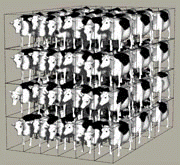Animal Science, Department of
Date of this Version
1986
Abstract
Developments in nonsurgical embryo transfer have made commercial application for beef and dairy cows feasible. DHIA records were used to determine milk production variability within dairy herds. The top 10 percent of cows within herds produced 43 percent more milk that the herd average compared with 49 percent below herd average for the bottom 10 percent. The top 10 percent of cows within DHIA herds were assumed to be embryo donors for the remainder of the cows in DHIA herds. Economic implications were assessed for the U.S. dairy industry by region. Feed required to support the higher milk production level increased 296 kg while net income increased $161 per cow per year (assuming no affect on milk price). Aggregate milk production would increase by 6 percent if cow numbers remained the same. Approximately 6 percent fewer cows would be required to produce the present level of milk production if less efficient producers were forced to stop producing (11 percent of non-DHIA herds). Dairymen could pay $533 for each 1000 kg increase in milk production potential for an embryo transplant heifer calf at current milk and feed prices.


Comments
Published in 3rd World Congress on Genetics Applied to Livestock Production, edited by Gordon E. Dickerson and Rodger K. Johnson, 4 vols. (Lincoln: University of Nebraska Institute of Agriculture and Natural Resources, 1986). Copyright © 1986 Board of Regents University of Nebraska.